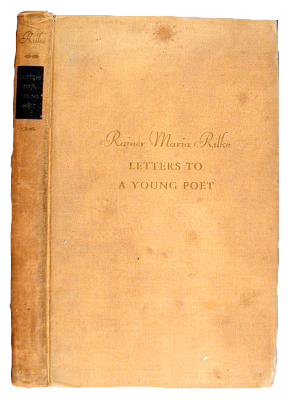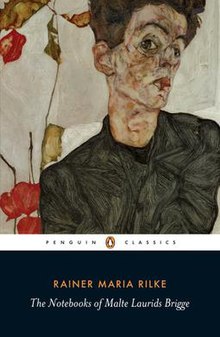A Künstlerroman, meaning "artist's novel" in English, is a narrative about an artist's growth to maturity. It could be classified as a sub-category of Bildungsroman: a coming-of-age novel. According to Encyclopaedia Britannica, one way a Künstlerroman may differ from a Bildungsroman is its ending, where a Künstlerroman hero rejects the everyday life, but a Bildungsroman hero settles for being an ordinary citizen. According to Oxford Reference, the difference may lie in a longer view across the Künstlerroman hero's whole life, not just their childhood years.

René Karl Wilhelm Johann Josef Maria Rilke, known as Rainer Maria Rilke, was an Austrian poet and novelist. Acclaimed as an idiosyncratic and expressive poet, he is widely recognized as a significant writer in the German language. His work is viewed by critics and scholars as possessing undertones of mysticism, exploring themes of subjective experience and disbelief. His writings include one novel, several collections of poetry and several volumes of correspondence.
This article contains information about the literary events and publications of 1910.

Jens Peter Jacobsen was a Danish novelist, poet, and scientist, in Denmark often just written as "J. P. Jacobsen". He began the naturalist movement in Danish literature and was a part of the Modern Breakthrough.
Stephen Mitchell is a poet, translator, scholar, and anthologist. He is best known for his translations and adaptions of works including the Tao Te Ching, the Epic of Gilgamesh, works of Rainer Maria Rilke, and Christian texts.

New Poems is a two-part collection of poems written by Bohemian-Austrian poet and novelist Rainer Maria Rilke (1875–1926). The first volume, dedicated to Elisabeth and Karl von der Heydt was composed from 1902 to 1907 and was published in the same year by Insel Verlag in Leipzig. The second volume, dedicated to Auguste Rodin, was completed in 1908 and published by the same publisher. With the exception of eight poems written in Capri, Rilke composed most of them in Paris and Meudon. At the start of each volume he placed, respectively, Früher Apollo and Archaïscher Torso Apollos, poems about sculptures of the poet-God.
Burton Pike was an American translator of Robert Musil, as well as a distinguished professor emeritus of comparative literature and Germanic languages and literature at the CUNY Graduate Center.
The Icelandic Literary Society, founded in 1816, is a society dedicated to promoting and strengthening Icelandic language, literature and learning.

The Duino Elegies are a collection of ten elegies written by the Bohemian-Austrian poet Rainer Maria Rilke. He was then "widely recognized as one of the most lyrically intense German-language poets", and began the elegies in 1912 while a guest of Princess Marie von Thurn und Taxis at Duino Castle, on the Adriatic Sea. The poems were dedicated to the Princess upon their publication in 1923. During this ten-year period, the elegies languished incomplete for long stretches of time as Rilke had frequent bouts with severe depression—some of which were related to the events of World War I and being conscripted into military service. Aside from brief periods of writing in 1913 and 1915, he did not return to the work until a few years after the war ended. With a sudden, renewed burst of frantic writing which he described as a "boundless storm, a hurricane of the spirit"—he completed the collection in February 1922 while staying at Château de Muzot in Veyras, Switzerland. After their publication in 1923, the Duino Elegies were soon recognized as his most important work.
Edward A. Snow is an American poet and translator.

Michael Hulse is an English poet, translator and critic, notable especially for his translations of German novels by W. G. Sebald, Herta Müller, and Elfriede Jelinek.

Sigbjørn Obstfelder was a 19th-century Norwegian writer and poet.
Malte or Malthe is a male given name that is mainly used in Denmark, Sweden and Germany, which is from Old Danish Malti. It originated from Helmhold / Helmwald ("helmet-govern") or from former Low German and Old Danish short form of Old German names beginning with Mahal- "assembly". It described the advisor of the Thing (assembly).

Letters to a Young Poet is a collection of ten letters written by Bohemian-Austrian poet Rainer Maria Rilke (1875–1926) to Franz Xaver Kappus (1883–1966), a 19-year-old officer cadet at the Theresian Military Academy in Wiener Neustadt. Rilke, the son of an Austrian army officer, had studied at the academy's lower school at Sankt Pölten in the 1890s. Kappus corresponded with the popular poet and author from 1902 to 1908 seeking his advice as to the quality of his poetry, and in deciding between a literary career or a career as an officer in the Austro-Hungarian Army. Kappus compiled and published the letters in 1929—three years after Rilke's death from leukemia.

Tripmaster Monkey: His Fake Book is the third book written by Maxine Hong Kingston, and was published in 1989. The story follows Wittman Ah Sing, an American graduate of University of California, Berkeley of Chinese ancestry in his adventures about San Francisco during the 1960s. Heavily influenced by the Beat movement, and exhibiting many prototypical features of postmodernism, the book retains numerous themes, such as ethnicity and prejudice, addressed in Kingston's other works. The novel is rampant with allusions to pop-culture and literature, especially the 16th century Chinese novel Journey to the West.
Raffaello "Lello" Baldini, was an Italian poet in the Romagnol language.
Margaret Dows Herter Norton Crena de Iongh, known as Mary D. Herter Norton when she co-founded W. W. Norton & Company with her first husband, William Warder Norton, was an American publisher, violinist, and translator. She was known as M. D. Herter Norton for her work as a violinist and translator. Under the name M. D. Herter Norton, she translated from German about a dozen volumes of the poetry of Rainer Maria Rilke. Norton is noted for her dedication to giving "the closest idiomatic parallel" in her translation of Rilke poems. Among the translators working in her time, she was on the extreme end of being faithful to the "image, symbol, and elements of language" to the loss of the "technical elements of form" that would make a text a "living poems". Instead she offers the reader a literary aid to understand Rilke's words that accompany her line by line translation. Her second husband, Daniel Crena de Iongh, was an Executive Director and treasurer of the World Bank.
The Love and Death of Cornet Christopher Rilke is a prose poem written by Rainer Maria Rilke in 1899, revised in 1906, and published in 1912. Rilke wrote the poem after finding a document in his uncle Jaroslav's papers concerning Christopher Rilke, a man who Rainer's family erroneously believed to be an ancestor and who "died as a cornet in the baron of Pirovano's company of the Imperial Austrian Heyster Regiment of Horse." The poem recounts the adventures of Christopher Rilke, who travels with a company of soldiers and then, after a night in a castle with a lover, fights and dies in a war in Turkey and is mourned by an old woman.
Robert Vilain is a British literary scholar. He has been Fellow and Senior Tutor of St Hugh's College, Oxford, since September 2021. Previously he was Professor of German and Comparative Literature at the University of Bristol, where he still holds an Honorary Professorship, and Director of the AHRC-funded South, West and Wales Doctoral Training Partnership, a consortium of nine universities and National Museum Wales dedicated to funding and training PhD students. He is also Lecturer in German at Christ Church, Oxford, and responsible for the College's teaching in German.

Clémence de Bourges was a French poet and noblewoman, and a literary figure of the Renaissance.









